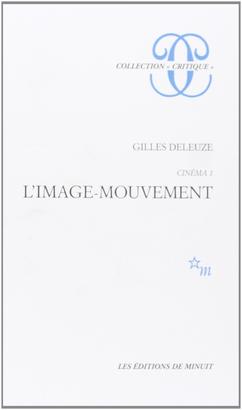Cinema 1: The Movement Image

Cover of the French edition
|
|
| Author | Gilles Deleuze |
|---|---|
| Original title | Cinéma 1. L'Image-Mouvement |
| Translator | Hugh Tomlinson |
| Country | France |
| Language | French |
| Subject | Philosophy, Film theory |
| Published | 1983 (Les Éditions de Minuit) |
| Media type | |
| Pages | 296 |
| ISBN | |
| OCLC | 11089931 |
| Preceded by | Francis Bacon - Logique de la sensation (1981) |
| Followed by | L'Image-temps. Cinéma 2 (1985) |
Cinema 1: The Movement Image (French: Cinéma 1. L'Image-Mouvement) is a 1983 book by the philosopher Gilles Deleuze, in which the author combines philosophy with film criticism. In the preface to the French edition Deleuze says that, "This study is not a history of cinema. It is a taxonomy, an attempt at the classifications of images and signs" and acknowledges the influence of the American pragmatist C. S. Peirce and the French philosopher Henri Bergson (p. xiv). The cinema covered in the book ranges from the silent era to the 1970s, and includes the work of D. W. Griffith, Abel Gance, Erich von Stroheim, Charlie Chaplin, Sergei Eisenstein, Luis Buñuel, Howard Hawks, Robert Bresson, Jean-Luc Godard, Sidney Lumet and Robert Altman. The second volume, Cinéma 2, L'Image-temps was published in 1985 (translated as Cinema 2: The Time-Image in 1989). Both books are clearly about cinema, but he also uses cinema to theorise time, movement and life as a whole.
Deleuze, commenting on the philosophy of Henri Bergson, dismisses the conception of cinema as a succession of still photographs. Instead, he argues that cinema immediately gives us movement-image. Figures are not described in a unique moment; rather, the continuity of movement describes the figure (p5). In this respect, cinema embodies a modern conception of movement, "capable of thinking the production of the new" (p7), as opposed to the ancient conception of movement as a succession of separate elements, exemplified by Zeno's arrow. The capacity for thinking the production of the new, being open to chance and accident, can be seen in the action-mime of Chaplin and the action dance of Fred Astaire (p7).
...
Wikipedia
